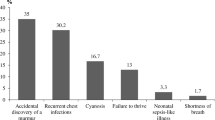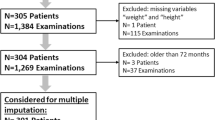Summary
The boy: girl ratio was calculated for all live births with cardiac malformation in Bohemia (population 6.3 million) from 1977–1984. Complete coverage of all deceased children in Bohemia by necropsy and of all patients with heart disease by our center enabled us to collect reliable data. Of 4409 children born with a heart defect, there were 2296 boys and 2113 girls, a ratio of 1.09: 1. In the total population of 664,218 children born during the same period of time, the ratio was 1.06:1. A higher proportion of boys was found with double outlet right ventricle (2.68:1), hypoplastic left heart (2.25:1), transposition of the great arteries (2.11:1), aortic stenosis (1.95:1), pulmonary atresia (1.55:1), tricuspid atresia (1.45:1), coarctation of the aorta (1.30:1), and corrected transposition of the great arteries (1.25:1). There were significantly more girls than boys with persistent ductus arteriosus (1:1.66), Ebstein's anomaly of the tricuspid valve (1:1.57), truncus arteriosus (1:1.22), atrioventricular septal defect (1:1.17), and tetralogy of Fallot (1:1.12). The difference in sex prevalence in the remaining heart defects was less than 10%.
Similar content being viewed by others
References
Bonham-Carter RE, Capriles M, Noe Y (1969) Total anomalous pulmonary venous drainage.Br Heart J 31:45–51
Braunwald E, Goldblatt A, Aygen MN, Roehoff SD, Morrow AG, (1963) Congenital aortic stenosis: I. Clinical and hemodynamic findings in 100 patients.Circulation 27:426
Bruins C, Dekker A (1968) Truncus arteriosus. In: Watson H (ed)Paediatric cardiology. Lloyd-Luke, London
Burroughs, JT, Edwards JE (1960) Total anomalous pulmonary venous connection.Am Heart J 59:913
Calder R, Van Praagh R, Van Praagh S et al. (1976) Truncus arteriosus communis: clinical, angiographic and pathologic findings in 100 patients.Am Heart J 92:23
Campbell M (1954) Simple pulmonary stenosis, pulmonary valvular stenosis with closed ventricular septum.Br Heart J 16:273
Campbell M (1968) Natural history of persistent ductus arteriosus.Br Heart J 30:514–526
Campbell M (1968) The natural history of congenital aortic stenosis.Br Heart J 30:514–526
Campbell M, Polani PE (1961) The etiology of coarctation of the aorta,Lancet 1:463–468
Carlgren LE (1958) The incidence of congenital heart disease in children born in Gothenburg 1941–1950.Br J Prev Soc Med 11:40–48
Chiariello J, Agosti J, Vlad P, Subramanian S (1976) Congenital aortic stenosis: experience with 43 patients.J Thorac Cardiovasc Surg 72:182–193
Craig RJ, Selzer A (1968) Natural history and prognosis of atrial septal defect.Circulation 37:805–815
Czeizel A, Kamaras J, Balogh O, Szentpeteri J (1972) Incidence of congenital heart defects in Budapest.Acta Pediatr Acad Scient Hung 13:191–202
Darling RC, Rothney WB, Craig JH (1957) Total pulmonary venous drainage into the right side of the heart: report of 17 autopsied cases not associated with other major cardiovascular anomalies.Lab Invest 6:44
Delisle G, Ando M, Calder AL et al. (1976) Total anomalous pulmonary venous connection: report of 93 autopsied cases with emphasis on diagnostic and surgical considerations.Am Heart J 91:99
Duff DF, Nihill MR, McNamara DG (1977) Infradiaphragmatic total anomalous pulmonary venous return: review of clinical and pathological findings and results of operation in 28 cases.Br Heart J 39:619
Feldt RH, Avasthey P, Yoshimasa F, Kurland LT, Titus JL (1971) Incidence of congenital heart disease in children born to residents of Olmsted County Minnesota 1950–1969.Mayo Clin Proc 46:794–799
Feldt RH, Weidman WH (1977) Defects of the atrial septum and endocardial cushion. In: Moss AJ, Adams FA, Emmanouilides GC (eds)Heart disease in infants, children and adolescents, 2nd edn, Williams & Wilkins, Baltimore
Friedberg CK (1966)Disease of the heart, 3rd edn. Saunders, Philadelphia
Fyler DC, Buckley LP, Hellenbrand WE, Cohn HE (1980) Report of the New England Regional Infant Cardiac Program,Pediatrics 65 [Suppl]:376–381
Gardiner JH, Keith JD (1951) Prevalence of heart disease in Toronto children.Pediatrics 7:713–721
Gasul BM, Arcilla RM, Lev M (1986)Heart disease in children. JB Lippencott, Philadelphia
Gathman GE, Nadas AS (1970) Total anomalous pulmonary venous connection: Clinical and physiologic observations of 75 pediatric patients.Circulation 42:143–154
Gross RE (1952) The patent ductus arteriosus: observations on diagnosis and therapy in 525 surgically treated cases.Am J Med 12:472
Kenna AP, Smithells RW, Fielding DW (1975) Congenital heart disease in Liverpool 1960–1969.Q J Med 44:17–44
Kidd BSL (1978) Complete transpositions of the great arteries. In: Keith JD, Rowe RJ, Vlad P (eds)Heart disease in infancy and childhood, 3rd edn. Macmillan, New York
Krovetz JL, Warden HE (1962) Patent ductus arteriosus: an analysis of 515 surgically proved cases.Dis Chest 42:46
Lauer RM, Fink H, Petry EL, Dunn MJ, Dicht AM (1964) Angiographic demonstrations of intramyocardial sinusoids in pulmonary atresia with intact ventricular septum.N Engl J Med 271:68
Liebman J, Cullum L (1969) Natural history of transposition of the great arteries: anatomy and birth and death characteristics.Circulation 40:237–262
Macmahon B, McKeown T, Record RG (1952) The incidence and life expectation of children with congenital heart disease.Br J Prev Soc Med 6:121–129
Marin-Garcia J, Tandon R, Moller JH, Edwards JE (1974) Common (single) ventricle with normally related great vessels.Circulation 59:564
Modie DS, Gill CC, Sterba R, Forsythe S (1986) The unnatural history of patients after surgical closure of atrial closure of atrial septal defects in adulthood. In: Dodyle EF, Engle MA, Gersony WM, Rashkind WJ, Talner NS (eds)Pediatric cardiology. Springer, New York
Muir CS (1966) Incidence of congenital heart disease in Singapore.Br Heart J 22:243–254
Nadas AS, Fyler DC (1972)Pediatric cardiology, 3rd edn. WB Saunders, Philadelphia
Noonan JA (1966) Hypoplastic left ventricle. In: Cassels DE (ed)Heart and circulation in the newborn and infant. Grune & Stratton, New York
Park SC, Mathews RA, Zuberbuhler JR (1977) Down syndrome with congenital heart malformation.Am J Dis Child 131:29–33
Record RG, McKeown T (1953) Observation relating to the aetiology of patent ductus arteriosus.Br Heart J 15:376–386
Ritter DG, Seward JB, Moodie D, Danielson GK (1979) Univentricular heart (common ventricle): preoperative diagnosis: hemodynamic angiocardiographic features.Herz 4:198
Rose V, Boyd ARJ, Ashion TE (1964) Incidence of heart disease in children in the City of Toronto.Can Med Assoc J 91:95–100
Šamánek M (1981) Transposition of the great arteries.Acta Univ Carol Med 27:3–133
Šamánek M, Goetzová J, Benešová D (1985) Distribution of congenital heart malformations in an autopsied child population.Int J Cardiol 8:235–248
Šamánek M, Slavík Z, Zbořilová B, Hroboňová V, Vořišková M, Škovránek J (1989) Prevalence, treatment, and outcome of heart disease in live-born children: a prospective analysis of 91,823 live-born children.Pediatr Cardiol 10:205–211
Shaher RM (1973)Complete transposition of the great arteries. Academic Press, New York
Schumacher G, Bühlmeyer K (eds) (1989)Diagnostik angeborener Herzfehler, 2nd edn. Perimed Fachbuch-Verlagsgesellschaft, Erlangen
Shinebourne EA, Tam ASY, Edwards AM, et al. (1976) Coarctation of the aorta in infancy and childhood.Br Heart J 38:375
Somerville J (1987) Aortic stenosis and incompetence. In: Anderson RH, Maccartney FJ, Shinebourne EA, Tynan M (eds)Paediatric cardiology, Vol. 2. Churchill Livingstone, Edinburgh
Sondheimer HM, Freedom JM, Ollez PM (1977) Double outlet right ventricle: clinical spectrum and prognosis.Am J Cardiol 39:79
Sridaromont S, Feldt RH, Ritter DG, Davis GD, Edwards JE (1976) Double outlet right ventricle: hemodynamic and anatomic correlations.Am J Cardiol 38:85
Sridaromont S, Ritter DG, Feldt RH, Davis GD, Edwards JE (1978) Double outlet right ventricle: anatomic and angiocardiographic correlations.Mayo Clin Proc 53:555
Tandon R, Edwards JE (1973) Cardiac malformations associated with Down's syndrome.Circulation 47:1349–1355
Tawes RL, Aberdeen E, Waterston DJ, Bonham Carter RE (1979) Coarctation of the aorta in infants and children: a review of 335 operative cases including 179 infants.Circulation 39 [Suppl I]:173–184
Van Praagh R, Van Praagh S (1965) The anatomy of common aortico-pulmonary trunk (truncus arteriosus communis) and its embryologic implications: a study of 57 necropsy cases.Am J Cardiol 16:406
Vesterby A, Nielsen K, Borg L, Paulsen S, Baandrup U (1987) Congenital heart malformations in Jutland, Denmark: a three year necropsy study in children aged 0–14 years. Epidemiology and classification ascording to segmental analysis.Br Heart J 58:653–658
Wagner HR, Ellison RC, Keane JF, Humphries JON, Nadas AS (1977) Clinical course in aortic stenosis.Circulation 56 [Suppl I]:I47-I56
Walloppillai NJ, Jayasinghe MS (1970) Congenital heart disease in Ceylon.Br Heart J 32:304–306
Weidman WH, Swan HJC, Dufhane JW, Wood EHA (1957) A nemodynamic study of atrial septal defect and associated anomalies involving the atrial septum.J Lab Clin Med 50:165
Weidman WH, Blount SG, DuShane JW (1977) Clinical course in ventricular septal defect.Circulation 56 [Suppl I]: 56–69
Wood P (1968)Disease of the heart and circulation, 3rd edn. Eyre & Spottiswood, London
Zetterquist P (1972)A clinical and genetic study of congenital heart disease. The Institute for Medical Genetics, University of Uppsala, Sweden
Author information
Authors and Affiliations
Rights and permissions
About this article
Cite this article
Šamánek, M. Boy:girl ratio in children born with different forms of cardiac malformation: A population-based study. Pediatr Cardiol 15, 53–57 (1994). https://doi.org/10.1007/BF00817606
Issue Date:
DOI: https://doi.org/10.1007/BF00817606




